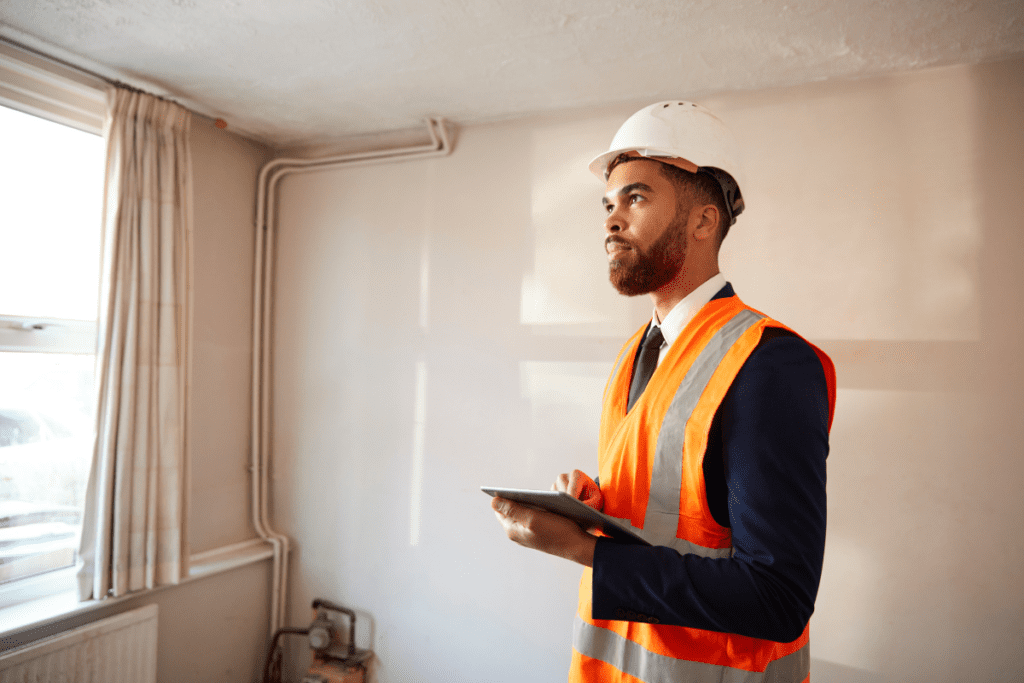You’ve probably heard of home surveys, or homebuyers surveys, when it comes to talking about buying, selling or renting properties. Or when it comes to looking at problems such as damp, mould and structural issues. That’s because home surveys are an important part of understanding the health of a building. But what is a home survey and what does it entail? And what are all the different types of home surveys available? Our ultimate guide breaks down everything you need to know about home surveys so you know what to expect.
What is a home survey?

A home survey is an assessment, which provides information about the condition of a property. A house survey is not the same as a property valuation. A valuation is an estimate of the current market value of the property. A survey highlights potential issues related to the condition of the building. It is incredibly beneficial to invest in a building survey if you are purchasing property. There are different types of home surveys available. In this guide, we’ll explore the differences between house surveys to help you decide which option is best for you.
What are the different types of surveys?

House surveys can be useful for any property. However, the type of property you intend to purchase will determine the type of survey you need.
There are three main types of home surveys provided by chartered surveyors. These include:
-
- Level 1: a basic overview of the condition of the property
-
- Level 2: a more detailed assessment that highlights defects and provides advice about repairs
-
- Level 3: a comprehensive report, which covers defects, home maintenance and repairs and advice related to remedial work
Level 1
The Level 1 Survey is the most basic survey, and also referred to as the Condition Report. It involves an inspection of the property, which includes the inside and outside of the building and any other permanent outbuildings. It’s aimed at new or recently-built homes that are in reasonable condition – usually homes built in the last 5 years. In general, it’s less thorough than the Level 2 or Level 3 home surveys, which is why it’s usually lower in price.
During the inspection, the surveyor will come to visit the property and – like the Level 2 Homebuyer Survey – use a traffic light system to score different aspects. The surveyor will look for common issues and summarise findings in a report.
It will also include energy efficiency, location and local environment information so the homeowner has a good understanding of the property.
Although this survey is the cheapest, most homebuyers opt for Level 2 or Level 3 surveys. This is because the Level 1 Survey does not involve advice on repairs or maintenance, or any costing, and is overall less comprehensive. It does however include legal advice for homeowners on issues that require attention before completing the purchase transaction.
Level 2
The Level 2 Survey, also known as the Homebuyer Survey, is the most common type of survey for homebuyers. It’s a mid-level property survey suited to buildings that are made of conventional materials and are in good condition. As a general rule, homes that have been built in the last 90 years, have been well maintained, and have not been hugely altered or modified are well-suited to the Level 2 Home Survey.
It also follows an inspection and a report, which uses the traffic light system. During the Level 2 inspection, the surveyor will look for any issues that may affect a property’s value, such as damp or harmful substances like asbestos.
What’s more, it will highlight any aspects that fall outside of building regulations. For this reason, many homeowners choose this type of survey before they finalise the purchase process on a property to make sure it is in good shape.
You can choose to have a valuation completed at the same time as a Level 2 Survey. This will provide even more information about the property’s market value, and help you understand whether you’re paying a fair price. If you need to renegotiate the asking price after receiving a lower RICS valuation, you can use the survey and valuation report as legal evidence.
Level 3
The Level 3 Survey, commonly referred to as the Building Survey, is the most detailed property survey available. It’s advised for older properties, homes that have been modified or are going to be renovated, or homes that are made of atypical building materials. It’s also the most appropriate home survey for buildings that have unusual designs or have not been well-maintained.
This high level of survey is usually longer, as it offers a more detailed and comprehensive inspection. The surveyor will inspect the roof, lifting up areas where necessary, any exposed floors, all rooms and windows and more. Although the surveyor will not pull up carpets or floorboards, they will look underneath them if they are already loose.
Any defects, issues or problems that your surveyor finds will be included in the report. They will also provide expert advice on repairs, as well as costs for repairs, maintenance and any renovation work.
The main difference that sets a Level 3 Survey apart from a Level 2 and Level 1 is that it can be tailored towards the homeowner’s needs. If there is a specific area of concern or something that requires special attention, the inspection and subsequent report can focus on this. The Level 3 Survey is adaptable and flexible, which is why it’s the most informative. However, this makes it a little more expensive than the other types of survey.
What kind of survey do I need?

The type of building survey you need will depend mostly on:
-
- The age of the property
-
- The materials your property is made from
-
- Whether or not you want to do any renovations
-
- How detailed or comprehensive you want the survey to be
The most important thing to remember when thinking about the different types of property surveys is that the higher the level, the greater the detail in the inspection. So if you want to do some restorative work or home improvements/renovations, you may want to get a higher level survey than homeowners moving into new build homes. For new properties, a basic survey may suffice.
It’s also advised to get a higher level survey if your property is over 50 years old or made from thatch, timber or other uncommon or historic materials. This is because these buildings are more prone to a range of defects and require a much more thorough investigation.
Generally, Level 2 home surveys are the most common type of building survey. Level 1 surveys may be suitable for small properties that are relatively new and in good condition, but Level 2 surveys are recommended for most buyers. This type of building survey is suitable for conventional homes, which have been constructed using common materials. Level 3 surveys are best for buyers looking to purchase old properties and those who are interested in taking on building work and projects, such as homes that need renovating or restoring. If you are unsure about which survey is best for you, contact an RICS surveyor and ask for recommendations based on your requirements.
What is included in a home survey?
The scope of a home survey varies according to which option you choose. Level 3 surveys are much more comprehensive than Level 1 reports. Here are some of the most significant factors to consider when choosing a survey:
-
- Roof
A surveyor will inspect the roof from the hatch in a Level 1 survey. For a Level 2 survey, they will access the roof space and walk around if possible. For a Level 3 survey, the surveyor will move possessions with permission and inspect insulation and materials to provide more information about the condition of the roof and highlight issues and defects.
-
- Windows
For Level 1 and 2 surveys, an RICS surveyor will open and inspect one window on each floor. For a Level 3 survey, the surveyor will inspect and open every window.
-
- Flooring
For a Level 1 survey, the surveyor will visually inspect the floors and test the stability via the heel drop test (this involves using the heel of the foot to stamp on the floor). For a Level 2 survey, the process is the same but the surveyor will also lift any hatches to assess the floor beneath. For a Level 3 survey, the surveyor will move furniture and lift exposed or loose flooring to inspect the area closely. They will also note down signs of sloping or deterioration.
-
- External areas
A Level 1 survey includes a basic visual inspection of the grounds. A Level 2 survey provides more detail through a thorough inspection, which may involve using ladders to assess areas that are not visible from the ground. The Level 3 survey is the same as the Level 2 survey, but the surveyor will flag any issues that could cost money to repair or resolve.
-
- Drainage
It is unlikely that a Level 1 report will contain any information about drainage. Level 2 surveys include a visual assessment of drains, while Level 3 surveys may include information about draining processes if the surveyor was able to observe and assess functionality.
Who does the survey when buying a house?
An RICS home survey is carried out by a RICS Chartered Surveyor, who provides surveys based on the RICS national guidelines. A home survey can help guide your decision on whether or not to buy a house or property, so it’s important you choose a surveyor that you feel comfortable with and know you can trust.
RICS Chartered Surveyors must adhere to regulated industry standards set out by RICS. This means your survey will be carried out by an independent party, who uses expertise and objective guidance to ensure you receive accurate information. It’s also a good idea to check out Trustpilot for reviews and recommendations.
At CJ Bloor, we’re proud of what our clients say about us. We have hundreds of 5-star reviews, which is down to our promise to deliver quality, expert knowledge and a friendly approach. 
Clarifying misconceptions: mortgage surveys vs. RICS home surveys
For those entering the property market for the first time, like first-time buyers, it can sometimes be confusing to understand the difference between a mortgage survey and a RICS survey. It’s a common mistake to think that a mortgage valuation survey is enough, as its purpose is merely to reassure the lender that the property is worth the amount of money they are lending. However, this is a far cry from the comprehensive assessment provided by a RICS survey.
Not investing a small sum in a RICS Survey could expose these individuals to the risk of potentially paying thousands of pounds later due to unexpected property issues. Investing in a detailed RICS survey allows you to have peace of mind knowing that there are no significant defects in your property, or at least you are fully aware of any areas that require improvement.
Home surveys provide information about the condition of a building. If you are thinking about making an offer, or you have found your dream home and you want to proceed with the acquisition, it’s hugely beneficial to pay for a house survey. Surveys can flag up issues that may not be visible during a viewing, they can provide reassurance for buyers and they can help you to avoid encountering unexpected costs further down the line. There are three types of surveys available. If you are buying an old house or a property that needs a lot of work, it’s wise to invest in a Level 3 survey, which is the most comprehensive type of report.




